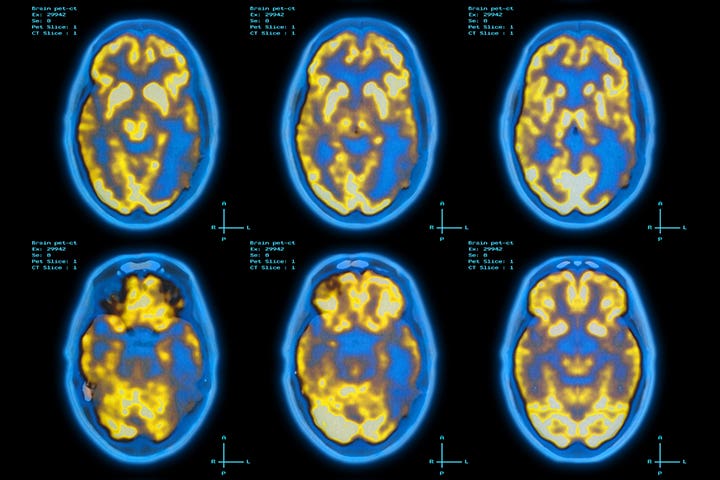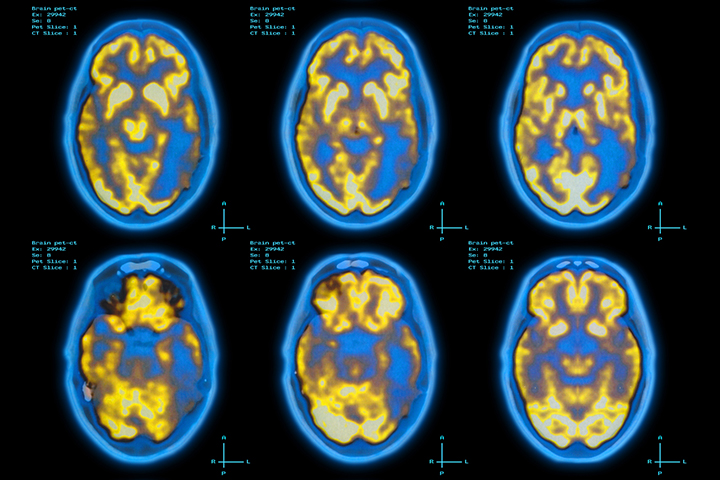Eric The Midget
Senior
- Joined
- Jul 27, 2018
- Messages
- 3,743
How the **** you going to get that emotional over pizza hut?
Hope this man finds peace.
Hope this man finds peace.
Here you go.Well, when you find a study that says otherwise, let's re-evaluate. Even if the number is skewed by families that donated based on their assumption something was wrong with their loved one, it may not include cases where former football players lived out the rest of their lives without observable effects of CTE, but that doesn't mean they didn't have CTE.
Also, just by saying Mark Walton has CTE, doesn't absolve any other potential diagnosis he may have...but the fact he's a former professional football player exponentially increases his risk of each and every single one of those diagnosis and with the information we have right now from the few studies that have been completed, the overwhelming evidence is that a significant majority of football players at the college level and above have some sort of CTE diagnosis post-mortem and in studies that cover THOUSANDS of football players that show increased risk all sorts of neurodegenerative disorders and thousands that report symptoms that are consistent with a CTE.
I'd specifically add schizophrenia and bipolar disorder to that list and as possible explanations. It is not at all uncommon for mental illness in men to present in early adulthood. In men, it is sadly pretty common for schizophrenia and bipolar disorder to first appear in that 18-25 age range. Mark recently turned 24 years old. He was 21 or 22 years old at the time of his first few wild arrests.
Is it possible he's got CTE? Yes.
Is it possible he has serious mental health issues? Yes.
Is it possible he has both CTE and serious mental health issue? Yes.
Is it possible he's just being a drunken *******? Sure, but I think that one is looking more and more unlikely with each incident.
Regardless, I hope he gets the help he needs before he hurts himself, someone else, or ends up in prison (or worse). If you've ever dealt with mental illness with a close friend or family member, you know it is serious and can completely change a person's behavior.
Here you go.

Largest study of CTE finds it in 6% of subjects
Nearly 6% of athletes and non-athletes were found to have the neurodegenerative disorder chronic traumatic encephalopathy (CTE) in the largest, and broadest, study conducted of the disease to date. Kevin F. Bieniek, Ph.D., of UT Health San Antonio is the lead author.www.sciencedaily.com
We aren't talking about "athletes (in the broadest sense) and non-athletes"...we're talking about professional football players which...ou're taking a study that is looking at the population at-large. Thats fine. But we're talking about professional football players here.
From the article you posted about CTE, "...linked with repetitive blows to the head, has been found in 80-99% of autopsied brains of pro football players." ... "American football had the highest frequency of CTE (15%) of the contact sports studied, with participation beyond high school resulting in the highest risk of developing CTE."
The famous study we've been discussing showed 21% for HS, 91% for college and 99% for professional football players. Nothing in the study you have provided really counters the conclusions of the previous study we were discussing. And, again, that study was just a little over a hundred donated brains at those three levels...you're trying to penny pinch what should be a pretty obvious conclusion.
We aren't talking about "athletes (in the broadest sense) and non-athletes"...we're talking about professional football players which...ou're taking a study that is looking at the population at-large. Thats fine. But we're talking about professional football players here.
From the article you posted about CTE, "...linked with repetitive blows to the head, has been found in 80-99% of autopsied brains of pro football players." ... "American football had the highest frequency of CTE (15%) of the contact sports studied, with participation beyond high school resulting in the highest risk of developing CTE."
The famous study we've been discussing showed 21% for HS, 91% for college and 99% for professional football players. Nothing in the study you have provided really counters the conclusions of the previous study we were discussing. And, again, that study was just a little over a hundred donated brains at those three levels...you're trying to penny pinch what should be a pretty obvious conclusion.
I still guarantee it's less than 99%. You have a ridiculously small sample size that's not independent.We aren't talking about "athletes (in the broadest sense) and non-athletes"...we're talking about professional football players which...ou're taking a study that is looking at the population at-large. Thats fine. But we're talking about professional football players here.
From the article you posted about CTE, "...linked with repetitive blows to the head, has been found in 80-99% of autopsied brains of pro football players." ... "American football had the highest frequency of CTE (15%) of the contact sports studied, with participation beyond high school resulting in the highest risk of developing CTE."
The famous study we've been discussing showed 21% for HS, 91% for college and 99% for professional football players. Nothing in the study you have provided really counters the conclusions of the previous study we were discussing. And, again, that study was just a little over a hundred donated brains at those three levels...you're trying to penny pinch what should be a pretty obvious conclusion.
I still guarantee it's less than 99%. You have a ridiculously small sample size that's not independent.
So tell me more about how you diagnosed a disease using a PET scan that can only be found in an autopsy.


If I want to know how PET scans work, I'll ask a nuclear medicine technologist. I want to know how YOU diagnosed him.I mean, you can guarantee anything you want, I don't care. The data points to a figure closer to 99% than whatever number you likely have in your head.
Your inability to understand a joke on the internet notwithstanding...
But PET scans - while in the experimental stage - are something that is being tinkered with in an attempt to diagnose CTE.
"They found that the tau PET levels were significantly higher in the former NFL players than in the control group, and that the tau was in the same areas of the brain as in post-mortem cases of diagnosed CTE."

Bad News for Tau PET Tracer in CTE
Only modest correlation between imaging result and actual pathology in ex-football playerwww.medpagetoday.com
To show that I'm not just using sources for confirmation bias...again, its still being worked on.
"...While the UCSF researchers found a similar FTP pattern to what was seen in the Boston University study and other research, "when we compared this signal to the amount of tau pathology, there was only a modest correlation," Mantyh told MedPage Today.
"Our case suggests this tracer may not be a home run for detecting CTE," said co-author Gil Rabinovici, MD, also of UCSF. "Unfortunately, it tempers some of the enthusiasm about the ability to use this tracer to detect CTE in living people because the correlations were quite modest and lower than what's been reported in Alzheimer's disease," he told MedPage Today..."
share to facebook
share to twitter
share to linkedin
email article

The PET tracer 18F-flortaucipir (FTP) may have limited utility as a tau pathology biomarker in chronic traumatic encephalopathy (CTE), findings from a case report suggested.
In a former National Football League (NFL) player with pathologically confirmed CTE, flortaucipir PET findings during life showed only a modest correspondence with postmortem CTE pathology, reported William Mantyh, MD, of the University of California San Francisco (UCSF), and colleagues, in JAMA Neurology.
This is the first report to describe a PET-to-autopsy correlation in a patient with CTE, Mantyh noted.
Currently, CTE can be diagnosed only after death. Last year, Boston University researchers reported that FTP PET scans showed elevated tau levels in brain regions affected by CTE in living former NFL players, suggesting FTP could detect CTE pathology in life.
While the UCSF researchers found a similar FTP pattern to what was seen in the Boston University study and other research, "when we compared this signal to the amount of tau pathology, there was only a modest correlation," Mantyh told MedPage Today.
"Our case suggests this tracer may not be a home run for detecting CTE," said co-author Gil Rabinovici, MD, also of UCSF. "Unfortunately, it tempers some of the enthusiasm about the ability to use this tracer to detect CTE in living people because the correlations were quite modest and lower than what's been reported in Alzheimer's disease," he told MedPage Today.
Flortaucipir was developed to detect Alzheimer's tangles and was validated against post-mortem tissue from Alzheimer's patients, he added. "It seems it doesn't bind quite as well to tau in CTE," he said.
"Biochemically, the composition of tangles in CTE and Alzheimer's is very similar, and some aspects of the filaments are similar," Rabinovici explained. "But what's been found is that there are actually differences in the folding of the filaments in these two disorders. Those kinds of differences could certainly impact the ability of a PET tracer to bind to the aggregates."
The case report involved a white former NFL player who played football for 17 years starting in high school, and who had been clinically diagnosed with traumatic encephalopathy syndrome. After retiring from football, he worked as a professional stuntman.
At age 57, he had depression, social withdrawal, episodic rage, anxiety, and a reduced ability to multitask. At 63, he developed postural tremor, stooped posture, and a shuffling gait; exams at ages 65 and 68 showed mild parkinsonism. He was clinically diagnosed with traumatic encephalopathy syndrome with behavioral, cognitive, mood, and motor features. At age 72, he developed recurrent seizures, was hospitalized, and died. About 52 months before his death, he underwent imaging, including FTP PET. His autopsy was performed using a neurodegenerative research protocol.
Pathology results showed he had stage 4 CTE, plus neurofibrillary tangles typical of Alzheimer's disease (Braak stage 3) and findings consistent with limbic argyrophilic grain disease and stage 2 limbic-predominant, age-related transactive response DNA-binding protein 43 (TDP-43) encephalopathy. Immunohistochemical analyses for alpha-synuclein and beta-amyloid were negative.
Agreed! If this is not classic erratic behavior associated with other athletes later diagnosed with CTE then nothing else is...I don’t believe there’s treatment for CTE, so I’m afraid he’s beyond help at this point. When they eventually examine his brain the results are going to be shocking.
If I want to know how PET scans work, I'll ask a nuclear medicine technologist. I want to know how YOU diagnosed him.
He’s ******* crazy. Clearly he’s not a good dude. If he doesn’t shape up, his next stop will be the penitentiary.How the **** you going to get that emotional over pizza hut?
Hope this man finds peace.
These are good questions and I agree with your point about there being "a range of possibilities for Walton's actions." The truth is that neurological and especially psychiatric illnesses are very difficult to diagnose with certainty. There is often disagreement even amongst clinicians about the correct diagnosis. For example, a person suffering with depression may get a diagnosis of major depressive disorder from one provider and a diagnosis of bipolar or schizoaffective disorder from another provider.I'm not making any assumption on 1 factor being more likely than any other.
What I'm saying is - I see a range of possibilities for Walton's actions - from having serious head trauma issues, to having emotional issues, to just being a jerk.
Like - if Ray Rice knocks out his wife - is that CTE? If Joe Mixon knocks out a girl at a bar - is that CTE? If Mark Walton hits his girlfriend - is that CTE?
There's probably thousands of guys who played football at some level who get into a fight or have some type of run in with the law every year - are you saying that we should assume CTE in all instances?
My questions is - what makes the CTE reason any more valid than just saying Walton's an ***?
to deny that CTE isn't the baseline discussion point for a former football player showing the pattern of behavior Mark Walton is showing is buffoonery that only the likes of those on CiS could muster the courage to type up.
I'd specifically add schizophrenia and bipolar disorder to that list and as possible explanations. It is not at all uncommon for mental illness in men to present in early adulthood. In men, it is sadly pretty common for schizophrenia and bipolar disorder to first appear in that 18-25 age range. Mark recently turned 24 years old. He was 21 or 22 years old at the time of his first few wild arrests.
Is it possible he's got CTE? Yes.
Is it possible he has serious mental health issues? Yes.
Is it possible he has both CTE and serious mental health issue? Yes.
Is it possible he's just being a drunken *******? Sure, but I think that one is looking more and more unlikely with each incident.
Regardless, I hope he gets the help he needs before he hurts himself, someone else, or ends up in prison (or worse). If you've ever dealt with mental illness with a close friend or family member, you know it is serious and can completely change a person's behavior.
This whole forum is a propaganda filled cesspool. More than half these dudes view Alex Jones conspiracy theories as alternative facts. Have you been to the COVID forum and seen some of the sources that were routinely cited? To say that they subvert science would be an understatement.
I don’t believe there’s treatment for CTE, so I’m afraid he’s beyond help at this point. When they eventually examine his brain the results are going to be shocking.
This forum is a propaganda filled cesspool. More than half these dudes view Alex Jones conspiracy theories as alternative facts. Have you been to the COVID forum and seen some of the sources that were routinely cited? To say that they subvert science would be an understatement.
Piece, as in a sliceHow the **** you going to get that emotional over pizza hut?
Hope this man finds peace.